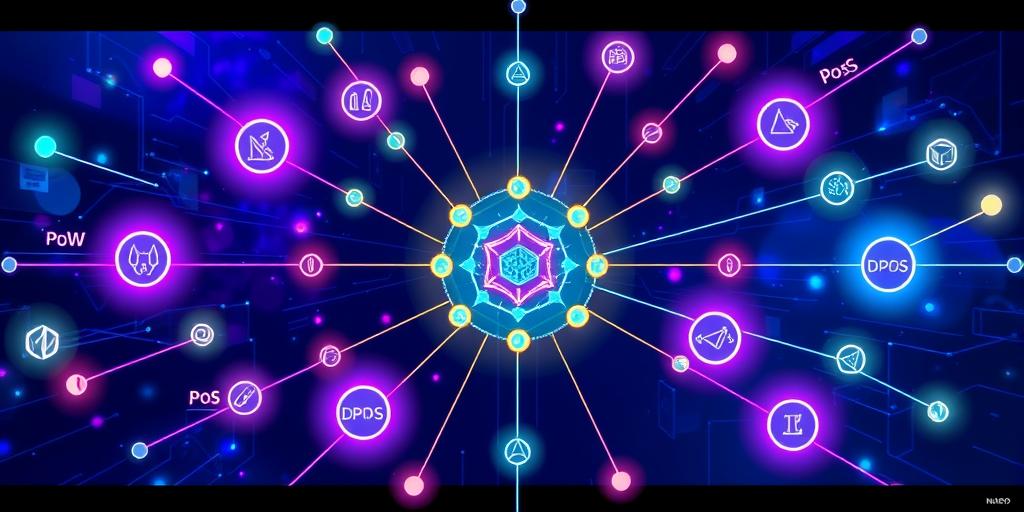Dive into the captivating world of blockchain consensus mechanisms! From the groundbreaking Proof-of-Work to the innovative Proof-of-Stake and beyond, we’ll unravel the intricate mechanisms that power the decentralized revolution. Prepare to be amazed as we explore how these ingenious systems ensure the security, integrity, and scalability of blockchain networks, shaping the future of finance and beyond. Get ready to become a blockchain expert in no time!
Understanding Blockchain Consensus Mechanisms: The Heart of Decentralization
At the core of every blockchain lies its consensus mechanism – the invisible hand that orchestrates the symphony of decentralized transactions. Think of it as the ultimate digital agreement, ensuring that all participants agree on the blockchain’s state. Without a robust consensus mechanism, the entire system would crumble, leaving it vulnerable to manipulation and chaos. This foundational element is responsible for maintaining the integrity and security of the blockchain. The security is paramount, making the choice of mechanism crucial for different blockchain applications.
Proof-of-Work (PoW): The OG Consensus Mechanism
First introduced with Bitcoin, Proof-of-Work (PoW) is a battle-tested consensus algorithm that has stood the test of time. It relies on a computationally intensive process where miners compete to solve complex cryptographic puzzles. The first to solve the puzzle gets to add the next block to the blockchain and is rewarded with newly minted cryptocurrency. This competitive nature ensures the security of the network, making it very difficult for malicious actors to alter the blockchain’s history.
Proof-of-Stake (PoS): Energy-Efficient Consensus
Proof-of-Stake (PoS) emerges as a more energy-efficient alternative to PoW. Instead of relying on computational power, PoS selects validators based on the amount of cryptocurrency they stake. Validators propose new blocks, and the network confirms them through a voting mechanism. This approach significantly reduces the energy consumption associated with consensus, making it a more sustainable choice for the environment.
Beyond PoW and PoS: Exploring Emerging Consensus Mechanisms
The world of blockchain consensus mechanisms is constantly evolving. Numerous innovative approaches are being developed and refined to address the unique challenges of different blockchain networks. Let’s explore some of these cutting-edge solutions:
Delegated Proof-of-Stake (DPoS): The Power of the People
In Delegated Proof-of-Stake (DPoS), token holders vote for delegates who will act as validators on their behalf. This system reduces the computational burden and enhances efficiency, making it suitable for large-scale networks. Think of it as a democratic approach to consensus, where the community’s collective voice determines the validation process.
Practical Byzantine Fault Tolerance (PBFT): Ensuring High-Throughput
Practical Byzantine Fault Tolerance (PBFT) shines in environments requiring high throughput and low latency. Unlike PoW and PoS, PBFT is based on a state machine replication model, ensuring that all nodes agree on the same state. However, PBFT’s scalability can be limited due to the necessity of communication between all nodes in the network.
The Future of Blockchain Consensus Mechanisms: Innovations on the Horizon
The landscape of blockchain technology is dynamic, and consensus mechanisms are no exception. Researchers are actively exploring innovative alternatives and improvements to existing methods. Hybrid approaches that combine the strengths of different mechanisms, improved scalability solutions, and environmentally-friendly algorithms are expected to be at the forefront of future blockchain developments. The pursuit of more efficient, secure, and scalable consensus mechanisms is essential for widespread blockchain adoption across various sectors.
Quantum-Resistant Consensus: Preparing for the Future
The advancement of quantum computing poses a significant threat to the security of current cryptographic systems, including many blockchain consensus mechanisms. The development of quantum-resistant consensus algorithms is crucial to ensuring the long-term security and resilience of blockchain technology. This ongoing research is of paramount importance as quantum computing matures.
Sharding: Scaling Blockchain for the Masses
Sharding is a technique that aims to improve blockchain scalability by dividing the network into smaller, more manageable shards. Each shard processes transactions independently, leading to significant increases in throughput. This is particularly crucial for blockchain networks handling a large number of transactions.
Choosing the right consensus mechanism is critical to the success of any blockchain project. Each has its strengths and weaknesses, and the selection depends heavily on the specific needs and goals of the network. The ongoing innovation in this field promises a future where blockchain technology becomes even more powerful and efficient. Ready to explore more blockchain technologies? Check out our latest resources now!




